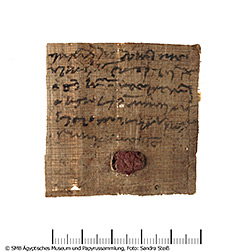SB XII 10915 (P. 13311 Fr. a)
Who was Satorneilos (Saturninus) for whom this customs receipt was issued? What cargo did he transport that was cleared through customs? What was it used for? The customs receipt does not answer any of these questions, although that is the whole point.
Customs receipts in general have at least three elements: the type of goods transported, the quantity of goods and the name and profession of the carrier. Both the place and the date are known in this case. The receipt was written in Soknopaiou Nesos on the 11th May 154 AD. Soknopaiou Nesos was an ancient settlement in the Fayum, southwest of Cairo in Egypt, and is located a few kilometres from Lake Qarun. The ruins are still very impressive despite all the time that has passed and are now known as Dimê. The place flourished especially in the Greco-Roman period.
From the Roman period, from which this gate customs receipt also originates, many customs registers kept by officials or, as in this case, customs receipts issued to individuals have survived, presenting us with a detailed picture of the customs system of the time. For example, we know of individual regulations for customs duty on imports from India and East Asia, which was levied along the entire eastern border, including the Red Sea coast. Since these imports were often rare luxury goods, the duty was relatively high. It was set at 25% of the declared value and was called a tetarte or quarter tax. Payment was not only in money, but also in kind. For example, the duty on nard and ivory imported from Muziris on the west coast of India required payment of 25 % of the imported goods. Customs duties were also sometimes levied on animals transporting the goods, usually about 1% of the value of the animal. You can see how inventive the state was and still is in its sources of revenue.
The papyrus is about a cargo, no longer identifiable from the text, for which 8 drachmas customs duty is charged. We do not know what exactly was being transported, as the text is not legible at this point. However, we learn from the receipt that the cargo was transported by Satorneilos with four camels, i.e. it was relatively large.
The receipt is written on papyrus, which has turned brownish over time. The writing is medium in size and cursive. It was written parallel to the fibres. In some places the papyrus is so thin that one can almost see through it. It is quite well preserved. There is a seal under the text. It is made of red clay that has been air-dried. The embossing of the seal can hardly be identified. The purpose of the seal was to certify that payment had been made. It was used like a signature.
Much can be deduced from what remains of the customs receipt today, but not the story behind it. What was the reason for Satorneilos to transport the goods? Was it trade? What was the cargo needed for? Finds like this usually raise more questions than they answer. Most of them we will never be able to answer. But they tell a lot about life at that time. It shows you how many things have remained the same over time. Receipts as well as taxes and customs duties still exist today. It is an old concept that has proven its worth. One can only guess what the story behind it is and hope that further finds will provide more details.



